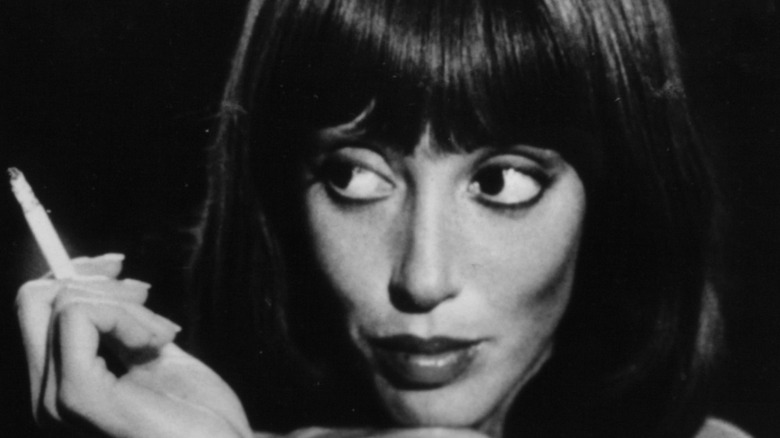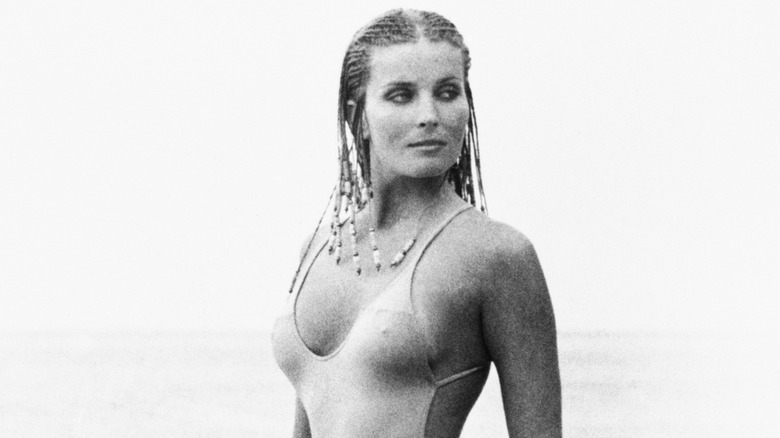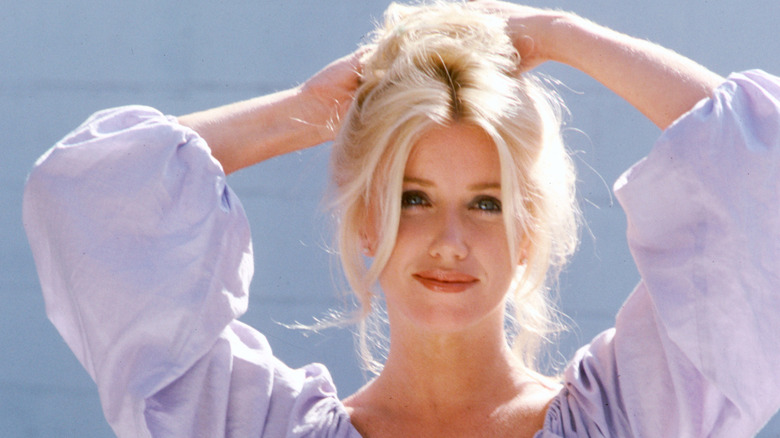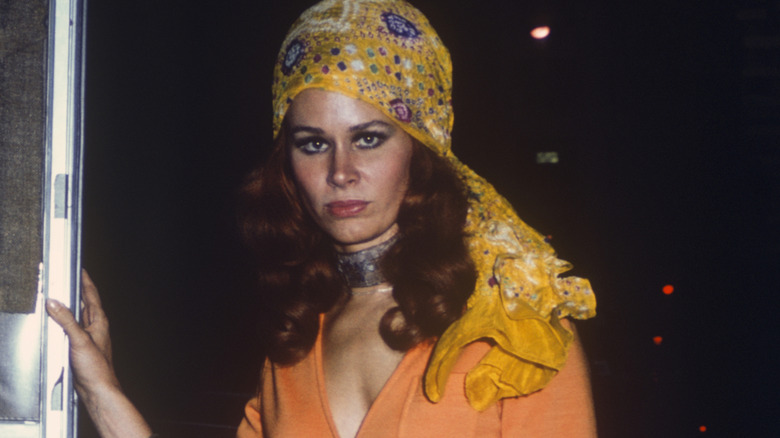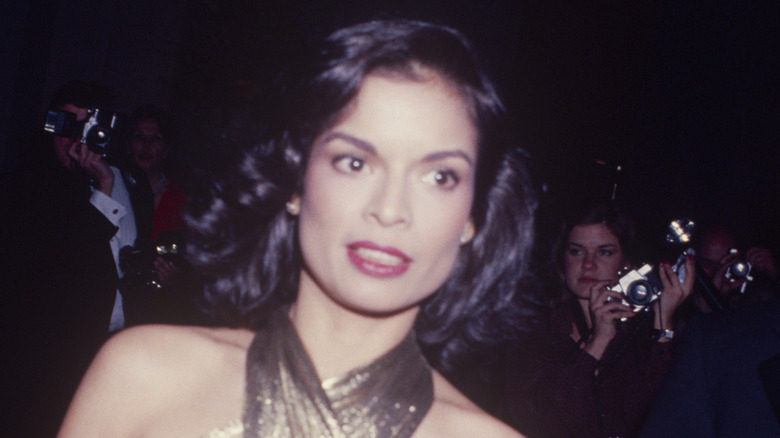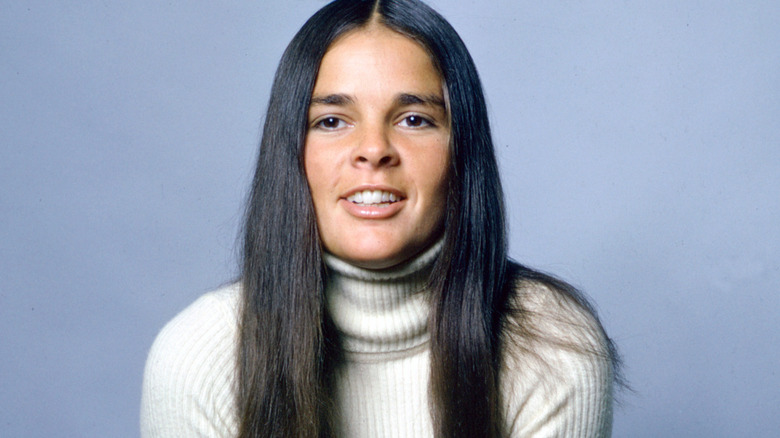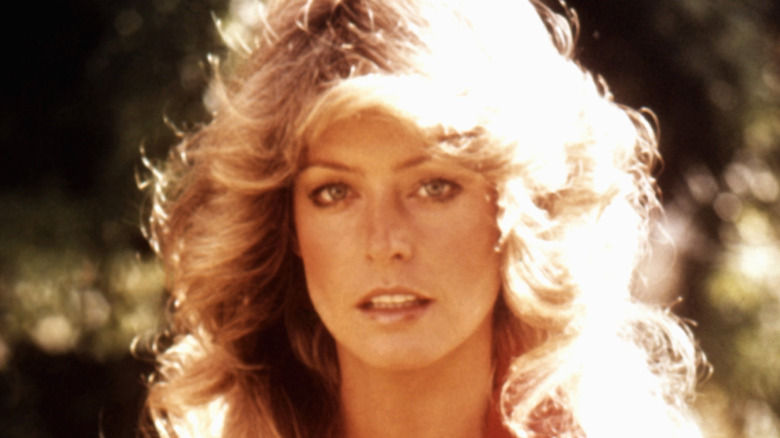Who Were The Real It Girls Of The 1970s And What Happened To Them?
Looking back at the 1970s, the decade crammed between the idealistic 1960s and the greed-is-good '80s is often maligned — and not without reason. This was, after all, the decade that brought about pet rocks, polyester leisure suits, shag carpeting, and eight-track tapes — an era when everybody smoked, nobody wore seat belts, and no teenage record collection was complete without a copy of "Frampton Comes Alive."
The '70s also brought about an array of famous females who came to define the era, some going on to success in future decades, while others faded from memory. Still, they were emblematic of the "It girl" tradition, in which certain women in certain time periods have not just become celebrities, but also actually influenced the culture at large, particularly in the world of fashion.
There were a number of women during that era who can lay claim to that unique title. To find out more, read on for a look back at the real It girls of the 1970s, and what happened to them.
Shelley Duvall retreated from Hollywood to reconnect with her family
Shelley Duvall made her screen debut in the 1970 film "Brewster McCloud." She quickly became a favorite of the film's director, Robert Altman, who cast her in his subsequent films. It was her role in Altman's 1975 hit "Nashville" that proved to be her breakout, with Duvall catapulting to stardom as spaced-out music groupie LA Joan.
With her wide eyes, high cheekbones, and delicate features, Duvall's unconventional looks contributed to her status as a Hollywood It girl throughout the decade, which included starring roles in several movies and a high-profile romance with singer-songwriter Paul Simon. She played starring roles in two very different 1980 films — Altman's "Popeye" and Stanley Kubrick's "The Shining" — and in 1983 went on to serve as creator, producer, and host of a beloved TV series, "Faerie Tale Theatre."
The more tragic details of Duvall's life include her brother's diagnosis of spinal cancer in the 1990s, which caused her to return to her native Texas and ultimately led to a two-decade hiatus from acting. "It's the longest sabbatical I ever took," she told People, "but it was for really important reasons — to get in touch with my family again." Duvall remained off Hollywood's radar until 2016, when she appeared on "Dr. Phil," looking disheveled, disoriented, and in psychological distress. Dr. Phil McGraw received widespread backlash for exploiting Duvall's apparent mental health struggles — one of the times he took things way too far on his show. After a brief acting comeback in the 2023 horror film "The Forest Hills," Duvall died in 2024 at the age of 75.
Bo Derek became a household name with 10 but her career faded after that
Mary Cathleen Collins was just 16 years old when she met future husband John Derek, who was 30 years her senior. They wed when he was 49 and she was 19, taking the name Bo Derek as she embarked on an acting career. After making her screen debut in the 1977 "Jaws" rip-off "Orca," she was cast in "10," director Blake Edwards' hit 1979 comedy, which starred Dudley Moore as a guy navigating a midlife crisis. While on a sunny tropical beach, Moore's character encounters Jenny (played by Derek, then 22) as she runs along the sand (in slow motion, of course) in a semitranslucent one-piece swimsuit, her hair in cornrows. The film was a hit, and that scene quickly became a classic, making Derek both a movie star and a cultural icon.
Truth be told, she fared better as an icon than an actor. Amid accusations that her Svengali husband was controlling her career, her subsequent films (including John Derek-directed stinkers such as "Fantasies," "Tarzan, the Ape Man," "Bolero," and "Ghosts Can't Do It") squandered her opportunity at movie stardom. Before long, she shifted to supporting roles (perhaps most memorably as the stepmom of Chris Farley's character in "Tommy Boy") and television.
These days, Derek acts only occasionally. Her recent projects have included the TV movies "JL Family Ranch" and "The Last Sharknado: It's About Time." She remained married until her husband's 1998 death at age 71. A few years later, she entered a relationship with the actor John Corbett, and they've remained a couple ever since. After nearly two decades of unwedded bliss, the two tied the knot in 2020.
Suzanne Somers' firing from Three's Company paved the way for the millions she earned from the Thighmaster
In 1977, Suzanne Somers was cast in a defining role that would catapult her from struggling LA actor to Hollywood It girl: ditzy Chrissy Snow on the ABC sitcom "Three's Company." The series became a ratings smash, and Somers was its breakout star. Somers correctly ascertained she was a big part of the show's success despite getting paid one-tenth of what her male co-star John Ritter was. "At that time, the men were making 10 to 15 times more than I was," Somers said in an interview (via Fox News). "And I was on the No. 1 show. It just seemed wrong because I was clearly being underpaid." ABC balked at her demand for a raise; instead, she was gradually written out of the show until she got fired and replaced when her contract was up after the fifth season. "Now, I was out of work and labeled 'trouble' only because I wanted to be paid fairly for doing my job," she recalled.
The less that is said about her next TV series after that, "She's the Sheriff," the better. However, she returned to sitcom glory during the 1990s with "Step by Step." Around that same time, Somers had reinvented herself by putting together a successful Las Vegas lounge act while also jumping into the fitness craze, rebranding herself as an exercise guru while hawking the Thighmaster on late-night infomercials. She went on to sell 10 million of the gadgets within the first two years — and stopped counting how many she sold after that. In her later years, she focused on her health and wellness empire, writing 27 books while selling a variety of merch ranging from clothing to supplements. She died in 2023 at the age of 76.
Bond girl Barbara Bach found lasting love with one of The Beatles
Barbara Bach was enjoying a successful career as a model and up-and-coming actor when she was tapped to become a Bond girl. That role, as Russian KGB agent Anya Amasova in 1977's "The Spy Who Loved Me," catapulted her to a level of fame she hadn't yet experienced. Her life changed even more significantly in 1980, when she met former Beatle Ringo Starr, her co-star in the 1981 comedy "Caveman." Sparks flew, which was somewhat inconvenient because both were in relationships at the time. By the final days of filming, however, they had extricated themselves from those relationships. As Bach recalled in a 1981 interview with Playboy, that was when their relationship took a sudden shift. "Then, all of a sudden, within a week — the last week of shooting — it just happened," she said (via People). "We changed from friendly love to being in love."
They wed in 1981, with Starr's former bandmates Paul McCartney and George Harrison in attendance; sadly, John Lennon had been murdered just a few months earlier. In the late 1980s, Bach and Starr — whose real name is Richard Starkey — went to rehab together, and have enjoyed a sober lifestyle ever since.
They've remained spouses, and Bach shared the simple secret to their marriage's longevity. "I love the man, and that's it," she told People in 2015.
Karen Black gravitated to indie films until her death in 2013
During the late 1960s and early '70s, a new breed of filmmaker emerged in Hollywood, the maverick young directors whose projects reflected the rebellious values of the era. Karen Black was at the center of this movement, starring in counterculture classics such as "Easy Rider," "Five Easy Pieces," and "Drive, He Said." Black's stardom rose throughout the decade, leading to roles in big-budget studio films such as "The Great Gatsby," "Airport 1975," and "The Day of the Locust."
However, one can only remain an It girl for so long. After her acclaimed performance alongside Cher in 1982's "Come Back to the 5 & Dime, Jimmy Dean, Jimmy Dean," Black continued to work in television and film, particularly in interesting roles in small indie films. No longer a leading lady, she settled comfortably into her new role as a character actor while racking up more than 200 screen credits in every conceivable genre — even tackling extreme horror in director Rob Zombie's 2003 gore-fest "House of 1000 Corpses." "Yes, that's my world — independent features. That's how I started," Black said in a 2007 interview with The Oregonian. "That's what I like. It's playful and comfortable and not stressful, and it's an individual's way of creating. You're not in the studio system imitating other people and yourself. I'm having a good life."
That good life came to an end in 2013, when the 74-year-old actor died from a rare form of cancer. Black remained a working actor right up until the end; in the year of her death, four of her projects were released, and two more premiered in 2015.
Diane Keaton won an Oscar and sparked a fashion trend with Annie Hall
Diane Keaton's big break came with a small but pivotal role in a 1972 film that would become legendary: "The Godfather." In addition to reprising her role in the sequel two years later, Keaton went on to be a leading lady in several films alongside then-boyfriend Woody Allen, including "Sleeper," "Love and Death," and "Annie Hall." In the latter, Allen based the titular Annie on Keaton, who wore her own quirky wardrobe in the film, including men's hats, coats, and neckties. Not only did Keaton win an Oscar for "Annie Hall," she also became a style icon, sparking a full-fledged fashion trend as women began outfitting themselves in the "Annie Hall" look.
"I look back on 'Annie Hall' and can't talk about that movie without talking about the fashion, it was everything to me," she wrote in her book "Fashion First" (via The Gloss). "I loved being able to dress like myself. My muses were the women of New York City who were walking the streets of Soho in baggy trousers and a blazer. I was layering pieces."
Keaton went on to even greater movie stardom in the decades that followed, including in "The Little Drummer Girl," "Baby Boom," "Father of the Bride" (and its sequels), "The First Wives Club," "Something's Gotta Give" (in which she romanced Keanu Reeves), and more recently, "Book Club." Through it all, Keaton remained a beloved cultural figure whose It girl status didn't so much evaporate as it evolved and matured. Fans were deeply saddened when she passed away in October 2025 at the age of 79.
Stevie Nicks impacted fashion while creating one of the biggest albums of the '70s
British blues band Fleetwood Mac had been through several iterations when guitarist Lindsey Buckingham and singer Stevie Nicks were invited into the fold. The duo — at that point a couple, and then fractiously very much not so — revitalized the band, with Nicks responsible for singing and writing hits such as "Dreams," "Landslide," "Rhiannon," "Gold Dust Woman," and "I Don't Want to Know." The band's 1977 "Rumours" album, bursting with Nicks-sung hits, sold 40 million copies, becoming the sixth-biggest album of the decade.
With her songs dominating top-40 radio, Nicks' reach as rock's It girl also extended to fashion. Known for her love of scarves, flowing chiffon, and Victorian-era ruffles — to say nothing of the occasional top hat — her bohemian, pseudo-witchy style was imitated by the countless teenage girls who grooved to her music.
Nicks has remained a constant presence in Fleetwood Mac over the years, although her messy feud with Buckingham has presented a steady succession of bumps in the road. She also established herself as a successful solo artist with hits such as "Stand Back" and "The Edge of Seventeen." It's fair to say that Nicks' music has permeated pop culture to the point that even she finds herself compelled to listen when "Dreams" plays on the radio. "Oh, totally!" she told Mojo with a laugh. "If I'm out walking and it comes on down the street, I stop people and tell them, 'That's me!'"
After her divorce from Mick Jagger, Bianca Jagger devoted herself to humanitarian issues
Nicaraguan model Bianca Pérez-Mora Macías met Rolling Stones frontman Mick Jagger in 1970, and it was love at first sight. "It sounds silly, but it was like a bolt of lightning," she told People. They were married the following year, and she became known as Bianca Jagger. Often described as an It girl, Bianca became a fixture at celebrity-studded Studio 54 during its '70s heyday, hobnobbing with the likes of Liza Minnelli and Andy Warhol. She forged a close friendship with designer Halston, serving as both his muse and the embodiment of his style — which was evident when she arrived at the nightclub decked out in a Halston gown while riding atop a white horse.
The marriage did not last; in 1978, she sued on the grounds of adultery, and their divorce was finalized in 1980. Mick kept on rolling with the Stones, and continued to go forth and multiply, ultimately fathering eight children (just one of whom, daughter Jade, he shares with Bianca).
Meanwhile, the woman who'd been among the world's most famous socialite jet-setters took another path, devoting herself to activist causes such as social justice, human rights, and the environment. Not only is she president and founder of the Bianca Jagger Human Rights Foundation, she is also a Council of Europe Goodwill Ambassador and a member of the Executive Director's Leadership Council for Amnesty International USA.
Ali MacGraw moved to New Mexico after losing her Malibu home in a fire
Ali MacGraw catapulted to It girl status with "Love Story," the weepy 1970 tale of a romance that ends with a terminal illness. MacGraw's next movie, "The Getaway," teamed her with rugged Steve McQueen — who, thanks to their on-set affair, became her leading man in real life, ending her marriage to movie producer Robert Evans. MacGraw only worked sporadically after that — she has a mere 15 screen credits over the course of four decades — and decided to exit Los Angeles after a 1993 fire claimed her Malibu home. By then, she'd lost her passion for acting. "I definitely did that for the money," she told The Wall Street Journal of a 1985 guest spot on hit prime-time soap "Dynasty."
She settled in New Mexico and never looked back. Recalling her days as a Hollywood style icon, MacGraw admitted that she's simply thankful that she survived the instant stardom she experienced after "Love Story." "I'm empowered," she told The Cut, "by knowing that fashion icon or no fashion icon, I'm lucky to be alive and kicking." She also had some choice words about what being an It girl meant to her. "Please spare me 'It' and 'cool' and 'try too hard,'" she said. "Being cool is like a rope around your neck."
Farrah Fawcett quit Charlie's Angels to seek more serious roles — but not before selling 12 million posters
Just as millions of women sought Jennifer Aniston's "Rachel" hairstyle from "Friends," two decades earlier, women were desperate to imitate the layered shag of "Charlie's Angels" star Farrah Fawcett. As the breakout star of a show that was derided as the epitome of "jiggle TV," Fawcett became a cultural phenomenon, and it wasn't just because of her hair. A racy 1976 poster of Fawcett in a swimsuit adorned the bedroom walls of countless teenage boys — 12 million in fact, becoming the biggest-selling poster in history.
What fans didn't realize was that Fawcett was earning just $5,000 per episode, and a measly 2% of sales of the millions of lunchboxes, T-shirts, and other "Charlie's Angels" merchandise flying off shelves. When producers refused to cave to her demands — a rumored $75,000 per episode, and 10% of merch sales — she quit after just one season to pursue a movie career. However, those ambitions were hit by a backlash. "I was a TV sex symbol who wanted to be an actress. People thought I was really pretentious," she told People. As her movies tanked at the box office, Fawcett was sued by the producers of "Charlie's Angels." "The whole lawsuit almost sank me," Fawcett added. "The industry was furious with me and hostile."
Redemption came when critics showered praise on her performance in "The Burning Bed," a 1984 TV movie — along with Golden Globe and Emmy nominations. After that, Fawcett remained a familiar face on both movie and TV screens until her cancer-related death in 2009 at age 62.

